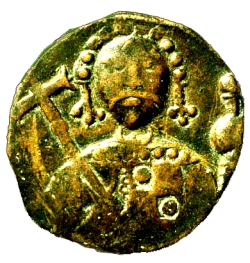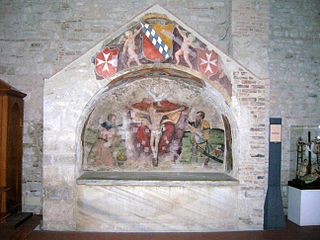Sources
- Lexikon de Mittelalters.
- Norwich, John Julius. The Normans in the South 1016-1130. Longmans: London, 1967.
Robert (died July 1080) was the first Norman count of Montescaglioso.
Robert had a brother, Geoffrey of Conversano. Their mother was a sister of Duke Robert Guiscard.
Along with his brother Geoffrey and his cousins, Abelard and Herman, Robert was constantly in rebellion against his uncle the duke. In April 1064, Robert joined Abelard, Geoffrey, and Joscelin, Lord of Molfetta, in rebellion against Robert, who had just left for Sicily. They received the aid, financial and military, of Perenos, the Byzantine duke of Durazzo. Between 1 September 1065 and 31 August 1066, Byzantine troops landed at Bari. The rebels held out for several years, neither making headway against Robert nor he against them. On 1 January 1068, Romanus Diogenes was acclaimed emperor in Constantinople and the Greeks transferred their military attention to the Seljuk threat to their east. The rebellion fell apart and by February Robert had surrendered.
In 1071, with Abelard, and in 1078, with his cousin Prince Jordan I of Capua, Robert was in rebellion again. Robert and his brother and cousins continued in rebellion after the 1079 peace between Jordan and the Guiscard. Robert was one of the first to cease revolting: he died in July 1080. He left a son, Rudolf, who succeeded him.
Bohemond I of Antioch, also known as Bohemond of Taranto or Bohemond of Hauteville, was the prince of Taranto from 1089 to 1111 and the prince of Antioch from 1098 to 1111. He was a leader of the First Crusade, leading a contingent of Normans on the quest eastward. Knowledgeable about the Byzantine Empire through earlier campaigns with his father, he was the most experienced military leader of the crusade.

Robert "Guiscard" de Hauteville, sometimes Robert "the Guiscard", was a Norman adventurer remembered for his conquest of southern Italy and Sicily in the 11th century.

Roger I, nicknamed “Roger Bosso” and “Grand Count Roger”, was a Norman nobleman who became the first Grand Count of Sicily from 1071 to 1101.

Roger Borsa was the Norman Duke of Apulia and Calabria and effective ruler of southern Italy from 1085 until his death.

Humphrey of Hauteville, surnamed Abagelard, was the count of Apulia and Calabria from 1051 to his death.
Richard Drengot was the count of Aversa (1049–1078), prince of Capua and duke of Gaeta (1064–1078).

Gisulf II was the last Lombard prince of Salerno (1052–1077).
William of Hauteville was one of the younger sons of Tancred of Hauteville by his second wife Fressenda. He is usually called Willermus instead of Wilelmus in Latin annals and so is often called Guillerm instead of Guillaume in French.
Herman of Hauteville was the younger son of Humphrey, count of Apulia and Calabria (1051–1057), and his Lombard wife, Gaitelgrima of Salerno, also known as Altrude. His older brother Abelard was supposed to inherit their father's lands, but Robert Guiscard, their uncle, who was elected count on Humphrey's death, confiscated them.

Abelard of Hauteville was the eldest son of Humphrey, count of Apulia and Calabria (1051–1057), and his Lombard wife, Gaitelgrima of Salerno, also known as Altrude. He was supposed to inherit his father's lands, but Robert Guiscard, his uncle and guardian, who was elected count on Humphrey's death, confiscated them.
Geoffrey the Elder was an Italo-Norman nobleman. A nephew of Robert Guiscard through one of his sisters, he was the count of Conversano from 1072 and the lord of Brindisi and Nardò from 1070, until his death.
Robert I was an Italo-Norman nobleman, the eldest son of Geoffrey of Hauteville, one of the elder sons of Tancred of Hauteville. He was the first count of Loritello in 1061.

The Hauteville was a Norman family originally of seigneurial rank from the Cotentin. The Hautevilles rose to prominence through their part in the Norman conquest of southern Italy. By 1130, one of their members, Roger II, was made the first King of Sicily. His male-line descendants ruled Sicily until 1194. Some Italian Hautevilles took part in the First Crusade and the founding of the Principality of Antioch (1098).

The Norman conquest of southern Italy lasted from 999 to 1139, involving many battles and independent conquerors.

The County of Sicily, also known as County of Sicily and Calabria, was a Norman state comprising the islands of Sicily and Malta and part of Calabria from 1071 until 1130. The county began to form during the Christian reconquest of Sicily (1061–91) from the Muslim Emirate, established by conquest in 965. The county is thus a transitional period in the history of Sicily. After the Muslims had been defeated and either forced out or incorporated into the Norman military, a further period of transition took place for the county and the Sicilians.
Peter II was the third Italo-Norman count of Trani. He was the youngest of three sons of Peter I; his elder brothers were Amico and Geoffrey.
Ranulf I was the count of Caiazzo in the Principality of Capua from about 1078. He also brought the formerly Lombard counties of Alife, Telese and Sant'Agata dei Goti and the castles of Airola and Tocco Caudio under his control, dominating the region between Capua and Benevento. He passed this territorial lordship on intact to his heirs, and it remained in their possession until the death of his grandson and namesake, Ranulf II, in 1139.
Abulchares was a Byzantine general of Arab origin who served as the catepan of Italy from 1064 until his death. The chief sources for his catapanate are Skylitzes Continuatus and Anonymi Barensis Chronicon. Skylitzes Continuatus records that Abulchares was also duke (doux) of Dyrrhachium across the Adriatic, but this is chronologically impossible, since Perenos is recorded as duke at this time.
Joscelin was a Norman count of Molfetta on the Adriatic coast of southern Italy. He rejected the leadership of Duke Robert Guiscard and rebelled, perhaps as early as 1064, certainly by 1067. Defeated, he went over the Byzantines in 1068.
Amicus of Giovinazzo, also Amicus II, was a Norman nobleman and military leader during the Norman conquest of southern Italy. He was the count of Molfetta from 1068 until his death and of Giovinazzo from 1068 until 1073. He came from a prominent family often opposed to the rule of the Hautevilles. In 1067–68, 1072–73 and 1079–80 he took part in rebellions against the Hauteville Duke of Apulia. In 1067 and 1079 he received aid from Byzantium against the duke.